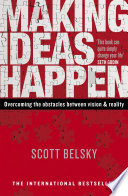

One of the central themes of 'Making Ideas Happen' is the significant impact of taking action. The book emphasizes that having great ideas is not enough; execution is key. The author, Scott Belsky, argues that many people get stuck in the ideation phase, dreaming about possibilities without moving forward. He introduces the concept of 'action bias,' which suggests that successful individuals are those who prioritize action over mere contemplation. Belsky provides practical strategies for overcoming procrastination and fear of failure, such as breaking projects into smaller tasks, setting deadlines, and maintaining accountability. By focusing on action, readers can translate their ideas into tangible outcomes, fostering a culture of productivity and innovation.
Continue readingBelsky emphasizes the importance of organization in the creative process. He introduces tools and techniques that help individuals and teams stay organized and focused. The book discusses the significance of project management systems, to-do lists, and collaborative platforms that can enhance productivity. Belsky argues that a well-organized environment allows for clarity of thought and reduces the chaos that often accompanies creative work. He also highlights the necessity of maintaining a balance between structure and flexibility, ensuring that while projects are organized, there is still room for spontaneity and creative exploration.
Continue readingThe book stresses the importance of collaboration and building a supportive community around ideas. Belsky argues that great ideas often emerge from collective input and diverse perspectives. He encourages readers to seek out collaborators who can provide different skill sets and insights, enhancing the creative process. The author discusses various methods for fostering collaboration, such as brainstorming sessions, feedback loops, and networking opportunities. By engaging with others, individuals can refine their ideas, gain new insights, and ultimately increase the likelihood of successful execution.
Continue readingIn a world filled with distractions, Belsky highlights the necessity of maintaining focus on the tasks that truly matter. He discusses the concept of 'distraction-free zones' and the importance of setting boundaries to protect one's creative time. The book provides techniques for minimizing distractions, such as time-blocking, digital detoxes, and prioritizing high-impact tasks. Belsky argues that by honing in on what is essential, individuals can cultivate deeper work and make significant progress on their projects. This focus not only enhances productivity but also leads to a more fulfilling creative process.
Continue readingBelsky introduces the idea of iterative development as a means to refine and improve ideas over time. He encourages readers to adopt a mindset of continuous improvement, where feedback is actively sought and used to enhance projects. The author discusses the importance of prototyping and testing ideas in real-world scenarios, allowing for adjustments based on user feedback. This iterative process not only leads to better outcomes but also fosters resilience, as individuals learn to embrace failure as a part of the creative journey. By iterating on ideas, individuals can create more robust and relevant solutions.
Continue readingAnother key idea in the book is the notion of embracing constraints as a catalyst for creativity. Belsky argues that limitations, whether they be time, resources, or scope, can actually enhance innovation by forcing individuals to think outside the box. He provides examples of successful projects that emerged from constrained environments, demonstrating how limitations can lead to unique solutions. The author encourages readers to view constraints not as obstacles but as opportunities for creative problem-solving. By reframing the narrative around constraints, individuals can unlock new levels of creativity and resourcefulness.
Continue readingFinally, Belsky discusses the importance of sustaining momentum once ideas are set in motion. He highlights the challenges of maintaining enthusiasm and energy throughout a project's lifecycle. The book offers strategies for keeping the momentum alive, such as celebrating small wins, setting incremental goals, and regularly revisiting the project's vision. Belsky emphasizes that sustaining momentum is crucial for long-term success and that individuals must actively cultivate motivation to navigate the inevitable ups and downs of the creative process.
Continue reading